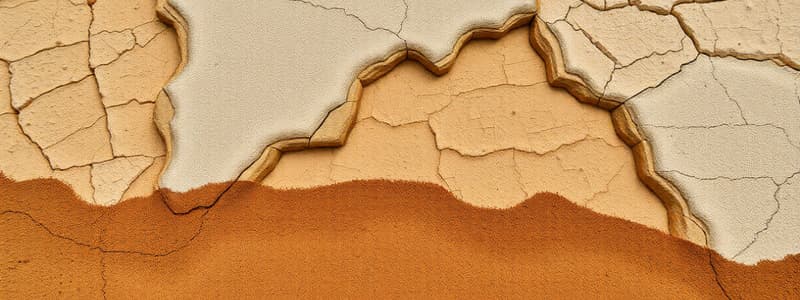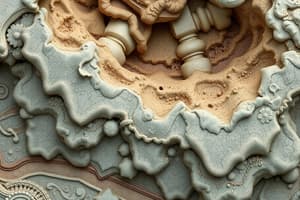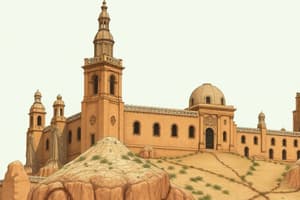Podcast
Questions and Answers
What is the primary composition of sandstone?
What is the primary composition of sandstone?
- Quartz (correct)
- Dolomite
- Limestone
- Calcite
Coquina is formed from tightly cemented shells and shell fragments.
Coquina is formed from tightly cemented shells and shell fragments.
False (B)
What are the features found in medium-grained rocks such as sandstone that indicate current flow?
What are the features found in medium-grained rocks such as sandstone that indicate current flow?
Ripple marks and cross-bedding
The sedimentary rock formed from microscopic shells and clay is known as __________.
The sedimentary rock formed from microscopic shells and clay is known as __________.
Match the following sedimentary rocks with their composition:
Match the following sedimentary rocks with their composition:
What process involves the breakdown of rocks into smaller pieces?
What process involves the breakdown of rocks into smaller pieces?
Chemical weathering changes the minerals within the rock without altering their chemical composition.
Chemical weathering changes the minerals within the rock without altering their chemical composition.
What term describes the removal and transport of sediment?
What term describes the removal and transport of sediment?
When sediments are deposited and transformed into rocks, the process is called __________.
When sediments are deposited and transformed into rocks, the process is called __________.
Match the following sedimentary features with their descriptions:
Match the following sedimentary features with their descriptions:
Which agent of erosion can move all material with equal ease?
Which agent of erosion can move all material with equal ease?
Sediments settle out in the order of their size when deposited.
Sediments settle out in the order of their size when deposited.
Name one process involved in lithification.
Name one process involved in lithification.
What is the primary feature of graded bedding?
What is the primary feature of graded bedding?
Ripple marks can only be formed by wind action.
Ripple marks can only be formed by wind action.
What are clastic sedimentary rocks primarily formed from?
What are clastic sedimentary rocks primarily formed from?
Angular sediments become __________ as they are transported and collide with each other.
Angular sediments become __________ as they are transported and collide with each other.
Match the sedimentary rock types with their descriptions:
Match the sedimentary rock types with their descriptions:
Which environments are primarily associated with fine-grained rocks?
Which environments are primarily associated with fine-grained rocks?
All ripple marks are symmetrical.
All ripple marks are symmetrical.
What is the most abundant type of biochemical sedimentary rock?
What is the most abundant type of biochemical sedimentary rock?
Flashcards are hidden until you start studying
Study Notes
Weathering and Erosion
- Weathering breaks down rocks into smaller pieces, known as sediments, through physical and chemical processes.
- These sediments are transported by water, wind, glaciers, and gravity.
- Sedimentary rocks form when these sediments are glued together.
Weathering
- Physical weathering breaks rocks into smaller pieces without changing the minerals within them.
- Chemical weathering alters the minerals within rocks by dissolving them, or changing their chemical composition.
- Chemical weathering leaves behind those minerals that are resistant to change.
Erosion
- Erosion is the removal and transport of sediment by wind, moving water, glaciers, and gravity.
- Eroded material is usually carried downhill.
Deposition
- Deposition occurs when the transport of sediments stops, and they settle out.
- The largest particles settle first, forming layers with progressively smaller grains at the top.
- Flowing water, wind, and glaciers can transport different sizes of sediment.
Lithification
- Lithification transforms sediment into sedimentary rock through compaction and cementation.
- Compaction occurs when the weight of overlying sediments squeezes out water and forces sediment grains closer together.
- Cementation occurs when mineral growth occurs between sediment grains, gluing them together into solid rock.
Sedimentary Features
- Sedimentary rocks provide a history of their formation and can help geologists interpret how they formed.
- Key features include bedding, graded bedding, cross bedding, and ripple marks.
Bedding
- The most common sedimentary rock feature.
- Consists of horizontal layers of sediment.
- Layers can range in thickness from a few millimeters to several meters.
Graded Bedding
- The particle sizes become progressively finer and lighter toward the top layers.
- Often seen in marine sedimentary rocks.
- Larger and heavier material settles out first, followed by finer material.
Cross Bedding
- Forms when layers of sediment are deposited at an incline across a horizontal surface.
- Occurs in sandy beaches, sandbars in streams and rivers, and migrating sand dunes.
Ripple Marks
- Form when wind or waves move sediment into small ridges.
- Symmetrical ripple marks form when waves push sand into symmetrical ridges.
- Asymmetrical ripple marks form when a current flows in one direction.
Angular vs Rounded
- Sediment initially has angular pieces when a rock breaks apart.
- As sediment is transported, pieces knock into each other and become rounded.
- The amount of rounding depends on the length of transport and how far the sediment travels.
Clastic Sedimentary Rocks
- The most common type of sedimentary rock.
- Formed from loose sediments that accumulate on Earth's surface.
- Classified by particle size.
Coarse-grained Rocks
- Consist of gravel-sized rock and mineral fragments.
- Include conglomerates, which have rounded, gravel-sized particles.
- Transported by high-energy flows of water, such as mountain streams, flooding rivers, ocean waves, and glacial meltwater.
Fine-grained Rocks
- Consist of silt and clay-sized particles.
- Form in swamps, ponds, and deep oceans, where water is still or slow-moving.
- Tend to be more layered than coarse-grained rock.
Chemical and Biochemical Sedimentary Rocks
- Formed through the evaporation and precipitation of minerals.
- Dissolved minerals are carried into lakes and oceans during weathering.
- Minerals are left behind when water evaporates.
Chemical Sedimentary Rocks
- Form when dissolved minerals in a body of water reach saturation and precipitate out of solution.
- Mainly found in arid regions, drainage basins on continents with low water flow, and coastal settings.
Biochemical Sedimentary Rocks
- Formed from the remains of once-living organisms.
- The most abundant is limestone, which is primarily composed of calcite.
- Shells of marine organisms settle to the bottom of the ocean and form layers of carbonate sediment.
- Calcium carbonate precipitates out of the water, forming limestone.
Table 2: Classification of Sedimentary Rocks
| Classification | Texture/Grain Size | Composition | Rock Name |
|---|---|---|---|
| Clastic | Coarse (> 2 mm) | Fragments of any rock type -quartz, rounded | |
| chert and quartzite common | Conglomerate | ||
| Medium (1/16 mm to 2 mm) | Quartz and rock fragments | Breccia | |
| Fine (1/256 mm-1/16 mm) | Quartz, potassium feldspar and rock fragments | Arkose | |
| Very fine (< 1/256 mm) | Quartz and clay | Siltstone | |
| Quartz and clay | Shale | ||
| Calcite (CaCO3) | Sandstone | ||
| Microcrystalline with conchoidal fracture | Quarts (SiO2) | Micrite | |
| Abundant fossils in micrite matrix | Calcite (CaCO3) | Chert | |
| Fossiliferous | |||
| Limestone | |||
| Shells and shell fragments, loosely cemented | Calcite (CaCO3) | Coquina | |
| Biochemical | Microscopic shells and clay | Chalk | |
| Variously sized fragments, ooids | Highly altered plant remains, some plant fossils | Coal | |
| Calcite (CaCO3) | Oolitic Limestone | ||
| Fine to coarsely crystalline | Calcite (CaCO3) | Crystalline Limestone | |
| Chemical | Fine to coarsely crystalline | Dolomite (Ca,Mg)CO3 | Dolostone |
| Very finely crystalline | Quartz (SiO2) -light colored; dark colored | Chert; Flint | |
| Calcite (CaCO3) | Micrite | ||
| Fine to coarsely crystalline | Gypsum (CaSO4 2H2O) | Rock Gypsum | |
| Halite (NaCl) | Rock Salt |
Medium-grained Rocks
- Consist of sand-sized sediments, such as sandstone.
- Contain several interesting features, such as ripple marks and cross-bedding, which indicate the direction of current flow.
- Contain relatively high porosity, making sandstone layers valuable reservoirs for oil, natural gas, and groundwater.
Studying That Suits You
Use AI to generate personalized quizzes and flashcards to suit your learning preferences.



